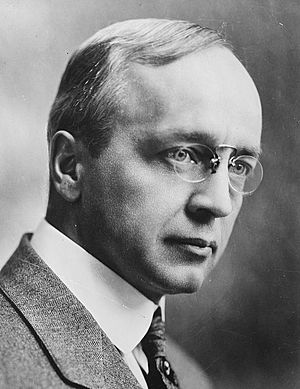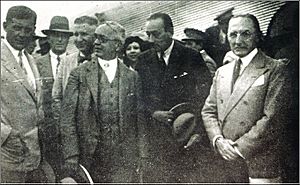Edwin W. Kemmerer facts for kids
Quick facts for kids
Edwin Walter Kemmerer
|
|
|---|---|
 |
|
| Born | June 29, 1875 |
| Died | December 16, 1945 (aged 70) |
| Influences | Jeremiah Jenks |
Edwin Walter Kemmerer (born June 29, 1875 – died December 16, 1945) was an American economist. An economist is someone who studies how money, goods, and services are made, shared, and used. Kemmerer became famous for helping many countries around the world with their money problems.
He gave advice to governments in places like the Philippines, Mexico, Germany, Chile, Poland, and China. His advice usually focused on having strong money, using the gold standard (where a country's money value is linked to gold), and having independent central banks. A central bank is like a country's main bank that controls its money supply. He also believed in balanced budgets, meaning a government shouldn't spend more money than it takes in.
Kemmerer also helped create the U.S. Federal Reserve System in 1911. This system acts as the central bank of the United States. He edited important economic magazines and became the president of the American Economic Association in 1926.
He studied at Wesleyan University and earned his Ph.D. from Cornell University. At 28, he became a financial adviser to the U.S. Philippine Commission. Later, he became a professor at Princeton University. He was known as an international "money doctor" because of his work helping countries fix their financial systems.
Contents
What were "Money Doctors"?
"Money doctors" like Edwin Kemmerer were economic advisers. They traveled to different countries to help them set up stable money systems. Their main goal was to connect countries' money systems to a global system based on gold. This meant that a country's money would have a fixed value compared to gold and other strong currencies.
To achieve this, their plans often required countries to have independent central banks. This means the central bank could make decisions about money without political interference. They also pushed for countries to pay back their debts and to have balanced budgets.
Sometimes, the advice from these "money doctors" was different. Also, their plans were designed not only to help countries follow international financial rules. They also aimed to help countries get important loans from other nations. Kemmerer was one of many such advisers. For example, Charles Dewey helped Poland after Kemmerer, and other experts advised countries like Romania, Hungary, and Germany.
Poland's Financial Challenges
After World War I, Poland faced big money problems, including very high inflation. Inflation means that prices for goods and services go up, and money loses its value. Poland tried twice to control this "galloping" inflation, but it was difficult.
In 1924, a plan helped stabilize prices, but it led to other issues. Poland also faced political instability. This situation became even harder when a special agreement with Germany ended in 1925. This agreement had required Germany to buy a lot of Polish coal, which was a big part of Poland's exports.
In May 1926, a military leader named General Pilsudski took power in Poland. His leadership brought more stability. At this time, the United States wanted to help rebuild Europe's economy after the war. This was important to protect trade and prevent more conflict.
Poland needed help with its money and new loans. Because of some disagreements between European countries, Poland decided to ask an American expert for help. They invited Edwin Kemmerer to create a plan for their economic reform and stabilization.
Kemmerer's Help in Poland

Edwin Kemmerer visited Poland for only a few months. His job was to study the situation and write a report with his recommendations. He was like a doctor who visits a patient, diagnoses the problem, and writes a prescription. Then, he leaves the patient to follow the treatment. Another economist, Charles Dewey, stayed in Poland much longer after Kemmerer left.
Kemmerer wrote a very detailed report about Poland's economy. He looked at everything from farming and industry to how the country communicated. He even included maps of the Polish Central Bank's offices and diagrams of its structure. He also mentioned that Poland needed a strong army because of its international challenges.
However, some people felt that his recommendations didn't fully consider Poland's unique situation. He suggested a system for managing the budget that he had used in other countries like Colombia and Chile. But Poland was known for its political instability, even with Pilsudski in charge.
In the end, having a famous American adviser like Kemmerer was also about prestige. Kemmerer himself said that if a country followed American financial advice, it would have a better chance of getting loans from American investors on good terms.
Kemmerer suggested that Poland borrow about $15 million to stabilize its money. However, Poland ended up getting a much larger loan of $61 million from American banks. Most of this money was for stabilizing their currency, the zloty, which was nearly four times what Kemmerer had recommended.
The idea was that this loan would lead to more loans and help Poland's economy grow. But by mid-1928, American banks stopped lending as much money overseas. This happened because interest rates in the U.S. went up, and people started investing more money at home. As a result, Kemmerer's efforts to stabilize Poland's economy didn't fully succeed, and the country faced more political problems.
Images for kids
See also
 In Spanish: Edwin Walter Kemmerer para niños
In Spanish: Edwin Walter Kemmerer para niños



